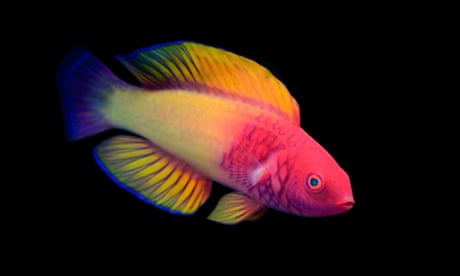A round the Maldives , between 40 and 70 metres (130-230ft) beneath the Indian Ocean, there are flickering shoals of brightly coloured, finger-length fish that never venture up to the coral reefs at the surface. The rose-veiled fairy wrasse ( Cirrhilabrus finifenmaa ) is one of many species that deep-diving scientists have found in the mesophotic (or twilight) zone, which lies between the sunlit shallows and the dark, deep ocean. It extends about 150 metres down and contains its own distinct mix of species.
“The mesophotic zone is one of the least explored regions in coral reefs,” says Yi-Kai Tea, postdoctoral fellow at the Australian Museum Research Institute in Sydney, by email from a research ship in the Indian Ocean. “This area is generally situated at an awkward depth – not deep enough to survey with submarines, too complex to trawl and dredge, and too deep to dive with traditional scuba techniques. ” Q&A What is the Discovered in the deep series? Show The ocean is one of the world’s last truly wild spaces.
It teems with fascinating species that sometimes seems to border on the absurd, from fish that look up through transparent heads to golden snails with iron armour. We know more about deep space than deep oceans, and science is only beginning to scratch the surface of the rich variety of life in the depths. As mining companies push to industrialise the sea floor and global leaders continue to squabble over how to protect the high seas , a new Guardian Seascape series will profile some of the most recently discovered weird, wonderful, majestic, ridiculous, hardcore and mind-blowing creatures.
They reveal how much there is still to learn about the least known environment on Earth – and how much there is to protect. Was this helpful? Thank you for your feedback. In order to photograph and collect specimens in the mesophotic zone, scientists use specialised diving gear that recirculates exhaled air rather than blowing bubbles straight into the water as regular scuba divers do.
By carefully controlling the mix of gases, scrubbing out excess carbon dioxide and adding more oxygen as required, rebreather divers can extend their dives to 100 metres. They need to take down several big gas cylinders and spend hours ascending slowly to decompress safely from these great depths, but in this way they can encounter species previously unknown to science in this little-known region. Discovered in the deep: the ‘forest of the weird’ Read more The rose-veiled fairy wrasse was named in 2022 : finifenmaa means rose in the local Dhivehi language – a double nod to the colourful fish and the Maldivian national flower, the pink rose, which goes by the same species name.
One of the scientists involved in finding and naming the new wrasse is Ahmed Najeeb from the Maldives Marine Research Institute. This is the first time a Maldivian researcher has described a new species native to the region, Tea says. Like other species of wrasse, the rose-veiled fairy wrasse change their appearance and sex as they age.
They start life as females and mature into males, becoming considerably more colourful. The males adorn themselves in stunning nuptial colours during the mating season, presumably to impress females. The finding was part of the California Academy of Sciences’ Hope for Reefs initiative, which aims to better understand and protect the world’s coral reefs, focusing on mesophotic reefs.
In 2019, Tea named another fairy wrasse discovered in the mesophotic zone off the coast of Zanzibar, Tanzania. Vibranium fairy wrasse ( Cirrhilabrus wakanda ) have vivid purple scales and, as the females transition to males their heads turn sunshine yellow. The Vibranium fairy wrasse was discovered in 2019.
Photograph: Luiz Rocha, California Academy of Sciences The name pays homage to the comic superhero Black Panther and his homeland Wakanda. “Like the elusive fictional nation of Wakanda … the wrasse has eluded science due to it living in obscure remote reefs deep beneath the surface,” says Tea. Vibranium is a fictional rare metal woven into Black Panther’s suit.
“The colours and patterns also reminded us of the garments used by the Wakandans in the movie,” he says. In the Maldives, the beautiful colours of the rose-veiled fairy wrasse have proved irresistible and they are already being collected from the wild for the ornamental aquarium trade, although currently they remain abundant. “As far as we know, they are not under any immediate risk,” says Tea.
.
From: theguardian
URL: https://www.theguardian.com/environment/2022/oct/19/discovered-in-the-deep-rainbow-fish-born-female-becomes-male



